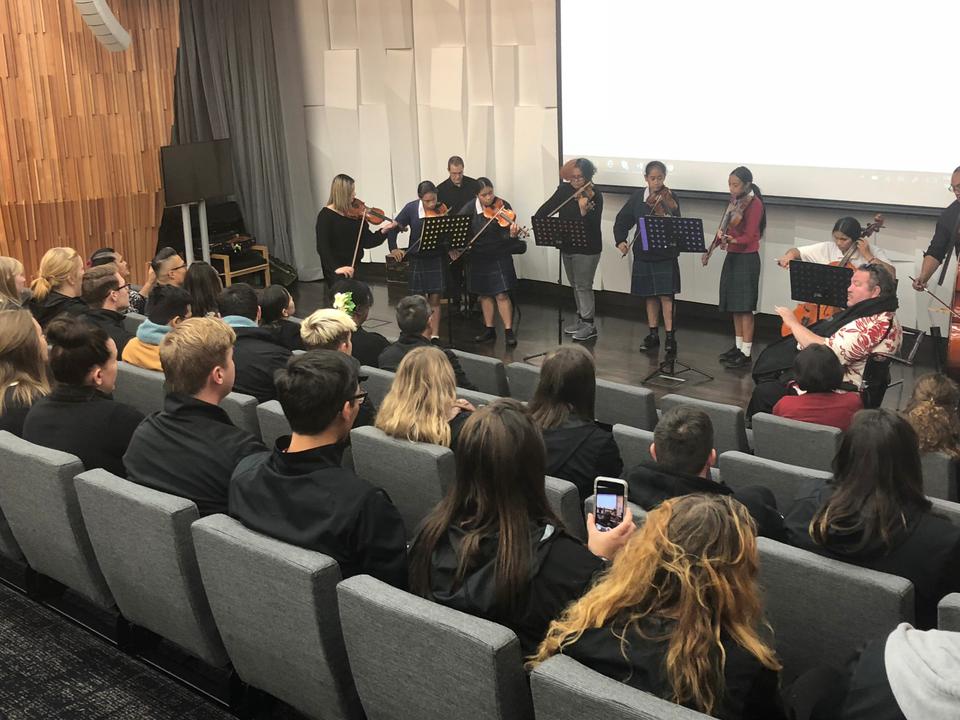The Brigham Young University—Hawaii Concert Choir was welcomed to Wellington, New Zealand on Friday June 7.
The premier choral group is continuing its Pacific “Voyages of Light” tour.
First, the choir met with performers of “Virtuoso Strings” at the National Library. Virtuoso Strings is an orchestra founded by local couple Elizabeth Sneyd and Craig Utting with the intent to provide opportunities for young people to learn an instrument and perform music to others.
At the Choir’s Wellington concert on Saturday evening, 40 members of Virtuoso Strings performed with the BYU—Hawaii choir.
At a musical exchange on Friday, the orchestra accompanied the choir as they sang “I am a Child of God.” The orchestra then played another number, from the movie score for “Legends of the Fall.”

“I taught a boy a dozen years ago who showed enormous talent," Utting says. "He was a Samoan boy from East Porirua and my wife thought there must be others out there and so she went out to two schools with eight violins under each arm to try to find other kids."
The program grew from there and now is in its sixth year. Virtuoso Strings works with a couple of hundred students every week. They have three orchestras. One for beginners, and for intermediate players, and a third, a senior orchestra for youth in grade 8 and up.
There are about 45 youngsters in the senior orchestra. Forty of those young people played with the BYU—Hawaii Concert Choir on Saturday night at the Alan Gibbs Centre at Wellington College.
During their Wellington stay, choir members were invited to attend a special event in a marae in Porirua, just north of Wellington.
A marae is a unique feature of Māori culture. It is a communal and sacred meeting ground which provides everything from eating, sleeping, religious and educational facilities.
As choir members entered the marae, after taking off their shoes, they were greeted with a traditional welcome.
At the conclusion of the gathering, the traditional hongi was shared between Māori leaders and choir members. A hongi is a type of greeting shared by pressing each other's noses and foreheads together.
After the marae visit, members of The Church of Jesus Christ of Latter-day Saints prepared a dinner for choir members. At the end of the dinner, the choir sang “Kua Rongo," a song sung in the Māori language, as thanks to their hosts.
Jeff Mellor, a singer in the choir describes what happens whenever the choir sings that song: “One of my favourite moments that we’ve had on the tour was when we were in Northland, north of Auckland, and we were singing the song “Kua Rongo” at a school.
"There is a moment in the song where we change the words for the city that we’re in, and we say the words “Te tai tokarau," the words for the Northland. As we sang it for the kids in that region there was just a really strong emotion in the room and you could tell that it was something that meant a lot to them."
He added, "For me it’s been one of the most magical moments on tour. When we can come and show respect for their culture, to me it’s just amazing.”
Being with the people of New Zealand continues to be a highlight of the tour for many choir members.
Adam Brace, a second tenor in the choir, said: “One of my favourite things about tour so far has just been being able to be with the host families that we’ve stayed with. I think it’s added so much to the tour that we wouldn’t have had otherwise.
"It is one thing to be able to stay in a hotel, but being here and being able to spend time with families has been so much more rewarding. It’s helped us to be able to feel the culture in a different way, to be able to spend time with the people that are here, to be able to appreciate that culture and enjoy it even more in our day.”